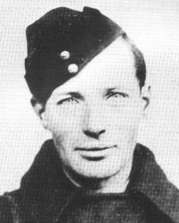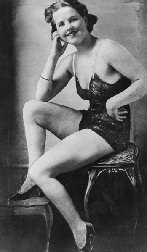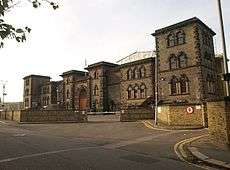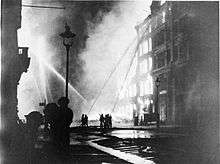Gordon Cummins
Gordon Frederick Cummins (18 February 1914 – 25 June 1942) was a British spree killer known as the Blackout Killer, the Blackout Ripper and the Wartime Ripper who committed the murders of four women and attempted to murder two others over a six-day period in London in February 1942. He is also suspected of committing two further murders in October 1941.
Gordon Frederick Cummins | |
|---|---|
 Gordon Frederick Cummins, c. 1941 | |
| Born | 18 February 1914 |
| Died | 25 June 1942 (aged 28) London, UK |
| Cause of death | Execution by hanging |
| Other names | The Blackout Ripper The Blackout Killer The Wartime Ripper |
| Occupation | Royal Air Force serviceman |
| Height | 5 ft 7 in (170 cm) |
| Criminal status | Executed |
| Allegiance | |
| Conviction(s) | 27 April 1942 |
| Criminal charge | Murder |
| Penalty | Death by hanging |
| Details | |
| Victims | 4–6 |
Span of crimes | 13 October 1941 or 9 February 1942 –14 February 1942 |
Convicted of the murder of 35-year-old Evelyn Oatley, Cummins was sentenced to death for her murder and was hanged at Wandsworth Prison on 25 June 1942.
Cummins became known as the "Blackout Killer" and the "Blackout Ripper" due to the fact he committed his murders during the imposed wartime blackout and because of the extensive mutilations inflicted upon three of his victims' bodies. He is known as the "Wartime Ripper" due to the fact his murders were committed at the height of World War II.
Early life
Gordon Frederick Cummins was born in New Earswick, North Yorkshire,[1][2] the son of John Cummins and his wife Amelia, née Lee. Cummins's father was a civil servant who ran a school for delinquent youths; his mother was a housewife. As a child, Cummins received a private education in Llandovery, South Wales, although contemporary reports describe his academic performance as unremarkable. After completing his schooling in 1930, Cummins attended Northampton College of Technology, earning a diploma in Chemistry.
At age 18, Cummins relocated to Newcastle, where he briefly worked as an industrial chemist. He was dismissed from this job after five months. He later found employment as a tanner, although he was fired from this employment for poor timekeeping,[3] thereafter alternating between parttime work and casual labour.In October 1934, Cummins relocated to London, obtaining a job as a trainee foreman in a clothing factory.[4]
As a young man, Cummins developed a desire to live the life of an aristocrat. He frequented hotels and clubs in the West End of London, falsely claiming to acquaintances to be the illegitimate son of a peer and also claiming receive an allowance from this fabled individual. He frequently engaged in acts of theft or embezzlement to financially maintain this facade.[5]
Royal Air Force
In early 1935, Cummins volunteered to join the Royal Air Force (RAF). He enlisted at the Air Crew Reception Centre in Regent's Park, London, where both serving members of the RAF and new recruits were assessed for training. This intake spanned from 2 to 25 February. Cummins initially trained as a rigger, tasked with undertaking flight checks on aircraft. His superiors consideed Cummins to be an ambitious individual, although Cummins was not popular among his fellow servicemen, who resented his boastful attitude and claims to hail from nobility. These false claims to hail from an aristocratic background earned Cummins the nicknames "the Duke" and "the Count".[6] In 1936, he married a theatre producer's secretary named Marjorie Stevens.[7] The couple had no children.[8]
Shortly after the outbreak of World War II, Cummins reached the junior rank of leading aircraftman,[6] although he held aspirations to become a Spitfire pilot.[9] At the time of his 1942 arrest for serial murder and attempted murder, Cummins had acquired neither a previous criminal record nor a known history of violence.[10]
Murders
Cummins is known to have murdered at least four women and to have attempted to murder two others over a period of six days in February 1942.[11] He is also suspected of murdering a fifth woman in October 1941. The majority of his victims were women whom he encountered in West End pubs and clubs and who engaged in prostitution—typically with servicemen.[12]
Cummins took advantage of the city's imposed wartime blackout conditions to commit his murders and attempted murders, thus becoming known by such epithets as the "Blackout Killer" and the "Blackout Ripper".[11][6]
First suspected murder
Cummins is suspected of committing his first murder on 13 October 1941. The victim was a 19-year-old clerk named Mabel Church, who is known to have frequently engaged in casual sexual relations with servicemen.[13] Her nude body was found by workmen in a bombed house on Hampstead Road the day after her murder. She had been strangled to death with her own camiknickers by an individual described by the pathologist who examined her body as being a left-handed individual, as the bruising around Church's neck indicated her murderer had more strength in his left hand than his right. In addition, her handbag had been emptied, with several contents missing.[14] Church had not been subjected to a sexual assault. Her death is believed to have occurred at approximately 9:15 p.m.[15]
At the time of this murder, Cummins was stationed in Colerne, Wiltshire, although when on leave, he is known to have frequently visited London, residing at an address in nearby St John's Wood.
On 10 November 1941, Cummins was posted to Cornwall. He was later transferred to the crew receiving centre in Regent's Park in early February 1942.[16]
Blackout murders
Evelyn Margaret Hamilton
On 8 February 1942, Cummins left an RAF establishment in St John's Wood to visit his wife, from whom he borrowed some money with the explanation he intended to visit the West End for a "night on the town".[17]
The following morning, the body of 41-year-old pharmacist Evelyn Hamilton was discovered by an electrician in a street-level air raid shelter in Montagu Place, Marylebone. Her clothes had been disarranged and her scarf wound about her head. Scuff marks on her shoes and broken sections of mortar indicated Hamilton had fiercely struggled with her attacker, who had raised her skirt above her hips and pulled her underwear below knee level. Her handbag—containing £80—had been stolen, although some of the contents were found strewn about the pavement outside the air raid shelter.[11]
The day prior to her murder, Hamilton had resigned from her position managing a Hornchurch chemists, and had planned to return to her native Newcastle. She was last seen alive by a waitress shortly before midnight the previous evening, drinking a glass of white wine to celebrate her 41st birthday. Her post-mortem revealed she had been manually strangled by a left-handed individual.[6] Hamilton had not been sexually assaulted or mutilated, although numerous small cuts had been inflicted to her right breast and a cut measuring one inch had been inflicted to her left eyebrow.[18]

Evelyn Oatley
On Monday, 9 February, the naked body of 34-year-old Evelyn Oatley (also known as Nita Ward) was discovered in her flat at 153 Wardour Street, Soho. Oatley was a former topless dancer and actress who had recently turned to prostitution.[n 1] Her nude body lay upon her bed. She had been strangled to death, her throat had been cut, and her abdomen, genitals and thighs had been extensively sexually mutilated with a can opener after death. A pair of curling tongs was also found close to her body.[11][6]
Fingerprints recovered from the bloodstained can opener (found near her body) and upon a broken mirror taken from her handbag which had also been used to mutilate her body confirmed suspicions that Oatley's murderer was a left-handed individual.[6] No match for this set of fingerprints could be found within the police fingerprint bureau, indicating Oatley's murderer had no police record.[20]
Margaret Florence Lowe
On Tuesday, 10 February, a 43-year-old widowed prostitute, Margaret Florence Lowe (also known as Pearl), was murdered in her flat at 11 Gosfield Street, Marylebone. She had been strangled to death upon her divan bed with a silk stocking which was still knotted around her neck. Her body had been extensively slashed and mutilated with a variety of implements including a razor blade, a knife and a poker, found beside her body. Forensic experts recovered fingerprints from a brass candlestick, a glass, and a half-drunk bottle of stout found at the crime scene. Her murder was quickly linked to that of Oatley.[21]
Upon examining Lowe's body, Forensic pathologist Sir Bernard Spilsbury remarked that her injuries were "quite dreadful", adding that her murderer was "a savage sexual maniac" who "indulged in a wicked lust to perpetrate the most diabolical injuries on the women he killed".[6][22]
Doris Jouannet
On Wednesday, 11 February 1942, 32-year-old Doris Jouannet (also known as Doris Robson) was murdered in the two-room ground-floor flat at 187 Sussex Gardens, Bayswater, that she shared with her elderly husband. She had been strangled with a scarf and her abdomen, genitals and thighs extensively mutilated with a razor blade in a similar manner to the bodies of Oatley and Lowe. Her naked body was discovered by her husband lying upon their bed.[6]
Jouannet led a double life: she secretly worked as a prostitute when her husband—who managed a West End hotel—slept overnight at the hotel.[23]
Press coverage
Due to wartime restrictions on newsprint, initially, the murders were not widely publicised. However, on 12 February, the bodies of both Lowe and Jouannet were discovered. The murders of Oatley, Lowe and Jouannet were linked to the same killer, whom the press dubbed the Blackout Killer, and the murders became nationwide headlines.[24]
13 February 1942
Margaret "Greta" Hayward
On the evening of 13 February 1942, Cummins accosted a young married woman named Margaret Hayward in Piccadilly. After sharing a drink and a sandwich at the London Trocadero, the two walked in the direction of Haymarket. Haywood later stated that at this point, Cummins became "unpleasantly forward" toward her, at which point she said goodbye and tried to leave. Cummins chased after her, seized her by the throat and pushed her into a shop doorway near Piccadilly Circus. Haywood was then strangled into unconsciousness.[25]
As Cummins rifled through her handbag, he was disturbed by a delivery boy carrying bottles of drink into the nearby Captain's Cabin pub, forcing him to flee the scene, leaving his RAF-issue gas mask in the doorway.[6][26]
Kathleen Mulcahy
Hours after his assault upon Margaret Hayward, Cummins accosted a young prostitute named Kathleen Mulcahy in Regent Street. Mulcahy agreed to take him to her flat in nearby Southwick Street. The two travelled to her flat via taxi, with Cummins giving her five £1 notes in advance. Upon entering her flat, Mulcahy lit her gas fire and began removing her clothes but did not remove her boots.[27][n 2] She later stated a "strange smile" appeared on Cummins's face as she removed her clothing. He removed his coat and belt, then approached Mulcahy and attempted to strangle her. Mulcahy fought her attacker, breaking free of his grasp, kicking his shins and screaming so loudly Cummins ceased his assault.[6][26]
Possibly as a means of deterring Mulcahy from reporting the assault to police, Cummins gave her a further five £1 notes before grabbing his coat and fleeing, leaving his RAF webbing belt at her address.[29]
Arrest
Cummins had left an item of his RAF-issued uniform at the scene of both attacks. His gas mask container and belt both bore his service number (525987).[11] As such, the Air Ministry were able to identify both articles as having been issued to Cummins, who was quickly traced to a billet in St John's Wood and arrested on 16 February, protesting his innocence and insisting he had been at his billet on 13 February.[6] Both Hayward and Mulcahy were asked to view a police lineup to identify their attacker. Mulcahy was unable to positively identify her attacker, although Hayward unhesitantly identified Cummins as the man who had assaulted her. Cummins continued to protest his innocence, claiming another cadet must have been in possession of his gas mask and belt, which he had noted were missing from his kit.[30]
Records within the billet pass-book indicated Cummins had reported back to the billet before midnight on the date of each murder and the two attempted murders investigators had ascribed to the Blackout Killer. However, questioning of Cummins's fellow airmen revealed they had been in the habit of vouching for each other's return to base. Detective Chief Inspector Edward Greeno further discovered Cummins and another airman had left the billet via a fire escape after midnight on each of the dates in question.[31]
A search of Cummins's possessions revealed he had taken various items belonging to the four murder victims linked to the Blackout Killer as keepsakes.[6][n 3]
Detective Chief Superintendent Frederick Cherrill, was able to match Cummins's fingerprints with those recovered from three of the crime scenes.[11] He was arrested and formally charged with murder on 16 February 1942.[10][6]
Trial
Cummins's trial for the murder of Evelyn Oatley began on 24 April 1942 at the Old Bailey, with Denis Nowell Pritt KC, the Member of Parliament for Hammersmith North, acting in his defence.[32] However, due to a legal technicality (presentation of an incorrect exhibit), the trial had to be restarted with a new jury on 27 April, the defence now being undertaken by Mr J. Flowers.[33] The evidence against Cummins was conclusive and, after a one-day trial, the jury took just 35 minutes to find him guilty of murder, and he was sentenced to death by hanging.

Execution
Cummins lodged an appeal against his conviction, although the Lord Chief Justice rejected this appeal in early June.[34] He was executed by Albert Pierrepoint at Wandsworth Prison on 25 June 1942.[35] His execution was conducted during an air raid.[6][32]
Charges for the other three murders remained on the file. Scotland Yard later stated they believed Cummins had likely murdered two first women in October 1941 while stationed in Colerne and prior to his November 1941 posting to Cornwall: Mabel Church (19) on 13 October and Edith Humphries (48) on 17 October.[10][36]
Media
Literature
- Honeycombe, Gordon (1982). The Murders of The Black Museum: 1870-1970. Hutchinson Publishing. pp. 371–377. ISBN 978-0-863-79040-9.
- Read, Simon (2006). In the Dark: The True Story of the Blackout Ripper. New York: Berkley Publishing Group. ISBN 978-0-425-21283-7.
Television
- The Crime & Investigation Network have broadcast an episode focusing on the Blackout Murders as part of their Murder Casebook series. Presented by Fred Dinenage, this 45 minute episode was first broadcast in November 2012 and features interviews with criminologist David Wilson.[37]
Notes
- Oatley was a married woman who would engage in prostitution on occasions her husband—who frequently travelled to Lancashire on business—was not present in London.[19]
- The night of 13-14 February had seen snowfall, and the weather was markedly cold. Mulcahy had kept her boots on as she undressed to avoid her feet coming into contact with the cold floor.[28]
- The search of Cummins's possessions revealed personal items such as a fountain pen, a pencil, two cigarette cases and a wristwatch which he had taken from each of his victims. The majority of these items were of little value.
References
- "FreeBMD Home Page". www.freebmd.org.uk. Retrieved 14 February 2020.
- The Murders of the Black Museum: 1870-1970 ISBN 978-0-863-79040-9 p. 372
- The Murders of the Black Museum: 1870-1970 ISBN 978-1-854-71160-1 p. 372
- "Blitz's Blackout Ripper". Daily Express. 18 August 2008. Retrieved 25 June 2020.
- The Murders of the Black Museum: 1870-1970 ISBN 978-1-854-71160-1 p. 372
- Stratford, Stephen. "British Military & Criminal History in the period 1900 to 1999, The 1940s - Gordon Cummins". stephen-stratford.co.uk. Archived from the original on 27 September 2007. Retrieved 10 August 2007.
- "Blitz's Blackout Ripper". Daily Express. 18 August 2008. Retrieved 25 June 2020.
- The Murders of the Black Museum: 1870-1970 ISBN 978-1-854-71160-1 p. 372
- "Blitz's Blackout Ripper". Daily Express. 18 August 2008. Retrieved 25 June 2020.
- "Crime in Wartime". Spartacus Educational. Archived from the original on 7 August 2007. Retrieved 10 August 2007.
- Choate, Trish (14 March 2007). "Recalling the 'Blackout Ripper' of Second World War London". Scripps News. Archived from the original on 25 March 2007. Retrieved 10 August 2007.
- The Murders of the Black Museum: 1870-1970 ISBN 978-0-863-79040-9 p. 371
- "Hampstead Murder Case: New Line of Investigation". Kalgoorlie Miner. 16 October 1941. Retrieved 17 June 2020.
- The Murders of the Black Museum: 1870-1970 ISBN 978-0-863-79040-9 pp. 375-376
- "Unsolved Murders: Mabel Church". unsolved-murders.co.uk. 1 January 2008. Retrieved 18 June 2020.
- Foul Deeds and Suspicious Deaths in Hampstead, Holburn and St Pancras ISBN 978-1-903-42594-7 pp. 143-144
- The Murders of the Black Museum: 1870-1970 ISBN 978-0-863-79040-9 p. 372
- "Murder Mile True-Crime Podcast #25 - The Blackout Ripper - Part 1 (Evelyn Margaret Hamilton)". Murder Mile Walks and True-Crime Podcast - one of the best "quirky, curious and unusual things to do in London" this weekend. Retrieved 14 February 2020.
- The Murders of the Black Museum: 1870-1970 ISBN 978-0-863-79040-9 p. 373
- "Murder Mile True-Crime Podcast #26 - The Blackout Ripper Part Two (Evelyn Oatley)". Murder Mile Walks and True-Crime Podcast - one of the best "quirky, curious and unusual things to do in London" this weekend. Retrieved 14 February 2020.
- "Blitz's Blackout Ripper". Daily Express. 18 August 2008. Retrieved 26 June 2020.
- "Murder Mile True-Crime Podcast #27 - The Blackout Ripper - Part 3 (Margaret Florence Lowe)". Murder Mile Walks and True-Crime Podcast - one of the best "quirky, curious and unusual things to do in London" this weekend. Retrieved 14 February 2020.
- "Murder Mile True-Crime Podcast #28 - The Blackout Ripper Part Four (Doris Elizabeth Jouanett)". Murder Mile Walks and True-Crime Podcast - one of the best "quirky, curious and unusual things to do in London" this weekend. Retrieved 14 February 2020.
- "Murder Mile True-Crime Podcast #28 - The Blackout Ripper Part Four (Doris Elizabeth Jouanett)". Murder Mile Walks and True-Crime Podcast - one of the best "quirky, curious and unusual things to do in London" this weekend. Retrieved 14 February 2020.
- The Murders of the Black Museum: 1870-1970 ISBN 978-0-863-79040-9 p. 374
- "Murder Mile True-Crime Podcast #29 - The Blackout Ripper - Part Five (Margaret "Greta" Hayward and Kathryn Mulcahy)". Murder Mile Walks and True-Crime Podcast - one of the best "quirky, curious and unusual things to do in London" this weekend. Retrieved 14 February 2020.
- The Murders of the Black Museum: 1870-1970 ISBN 978-0-863-79040-9 p. 374
- The Murders of the Black Museum: 1870-1970 ISBN 978-0-863-79040-9 p. 374
- "British Soldier Gordon Cummins Used German Air Raids to Become a Serial Killer". Argunners Magazine. 19 April 2020. Retrieved 20 June 2020.
- The Murders of the Black Museum: 1870-1970 ISBN 978-0-863-79040-9 p. 375
- The Murders of the Black Museum: 1870-1970 ISBN 978-0-863-79040-9 p. 375
- "Murder Appeal Dismissed". The Times (49258). London. 10 June 1942. p. 2. Retrieved 17 September 2013.
- "Trial Reopened Before New Jury, R.A.F. Cadet Accused Of Four Murders". The Times (49221). London. 28 April 1942. p. 2. Retrieved 17 September 2013.
- "Book Tells of York-born Killer's Reign of Terror". 11 January 2012. Retrieved 25 June 2020.
- "British Executions: Gordon Cummins". britishexecutions.co.uk. 1 January 2010. Retrieved 21 June 2020.
- "Unsolved Murders: Edith Eleanora Humphries". unsolved-murders.co.uk. 1 January 2010. Retrieved 21 June 2020.
- "Fred Dinenage: Murder Casebook". 3 February 2016 – via www.radiotimes.com.
Cited works and further reading
- Aston, Mark (2005), Foul Deeds and Suspicious Deaths in Hampstead, Holburn and St Pancras, Barnsley: Wharncliffe Books, ISBN 978-1-903-42594-7
- Bell, Amy (2014), Murder Capital: Suspicious deaths in London, 1933–53, Manchester: Manchester University Press, ISBN 978-0-719-09197-1
- Gaute, J. H. H. (1991), The New Murderers' Who's Who, New York: Dorset Press, ISBN 978-0-747-23270-4
- Gordon, Michael (2018), Murder Files from Scotland Yard and the Black Museum, North Carolina: Exposit Books, ISBN 978-1-476-67254-0
- Honeycombe, Gordon (1982), The Murders of the Black Museum: 1870-1970, London: Bloomsbury Books, ISBN 978-0-863-79040-9
- Lane, Brian (1995), Chronicle of 20th Century Murder, Bournemouth: Select Editions, ISBN 978-0-425-14649-1
- Morris, Jim (2015), The Who's Who of British Crime: In the Twentieth Century, Stroud: Amberley Publishing, ISBN 978-1-445-63924-6
- Read, Simon (2006). In the Dark: The True Story of the Blackout Ripper. New York: Berkley Publishing Group. ISBN 978-0-425-21283-7.
External links
- Contemporary news article detailing the murder charges filed against Gordon Cummins
- 2012 The Press news article regarding the Blackout Ripper murders
- British Executions case file pertaining to Gordon Cummins
- Crime & Investigation webpage pertaining to the Blackout Ripper
- PressReader article detailing the murders committed by Gordon Cummins
- The Blackout Ripper at oldpolicecellsmuseum.org.uk
